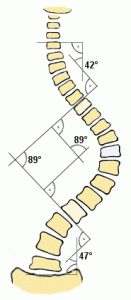 While not everyone has scoliosis, everyone has a curvature in their spine. The desingation is a matter of degree. Scoliosis describes a spine that is curved from side to side. Looking from the back at a spine, or x-ray of a spine, of someone with scoliosis and it will look more like an “S” or a “C” than a straight line.
While not everyone has scoliosis, everyone has a curvature in their spine. The desingation is a matter of degree. Scoliosis describes a spine that is curved from side to side. Looking from the back at a spine, or x-ray of a spine, of someone with scoliosis and it will look more like an “S” or a “C” than a straight line.
No one is perfectly even in the two halves of the body. We all have a dominant side and as a result there will be imbalances throughout the body and the spine will bear some of the imbalance. The extent of that imbalance is what matters most.
The Cobb angle is the measure that doctors use to determine the degree of curve in the spine. A curve of 10 to 15 degrees is usually left to its own devices. As the degree of curve increases a back brace is sometimes recommended but if the angle gets past the 40 degree range surgery is sometimes recommended.
The onset of scoliosis happens at different times for different reasons for different people. Some people are born with a curvature of the spine due to abnormalities already present. Many people develop scoliosis due to illness or trauma, and a third option is for scoliosis to develop for an unknown reason at different stages of life.
Depending on the point of view, scoliosis can be seen as the end result of a chronically tight psoas. If the tight psoas pulls the leg up into the spine and shortens the distance between the shoulder and the pelvis on one side there is going to have to be a corresponding affect on the opposite side. In this way the development of scoliosis can be seen as a compensation for the tight psoas.
One of the ways scoliosis is diagnosed is through the acknowledgement of a leg length discrepancy. Another is muscular imbalance on the opposite sides of the spine. Skeletally, ribs or a shoulder that are displaced often point to a case of scoliosis.
The simplest way to diagnose scoliosis is known as the Adams Forward Bend Test. If you align and stabilize your legs and then bend forward, the nature of your spine will reveal itself as you come forward. You would be able to see the aforementioned issues of spinal curve, imbalanced muscles and/or displaced ribs or shoulder blade.
